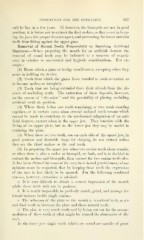Page 565 - My FlipBook
P. 565
INDICATIONS FOR THE OPERATION. 563
will be lost in a few years. If, however, the bicuspids are not in good
position, it is better not to extract the first molars, as they assist in keep-
ing the jaws the proper distance apart, and preventing the lower anterior
teeth from biting against the upper gum.
Removal of Sound Teeth Preparatory to Inserting- Artificial
Dentures.—AVhen preparing the mouth for an artificial denture the
removal of sound teeth may be indicated as a measure of expedi-
ency in relation to mechanical and hygienic considerations. For ex-
ample :
(1) Roots which a plate or bridge would cover, excepting when they
assist in holding the device.
(2) Teeth from which the gums have receded to such an extent as
to become useless or unsightly.
(3) Teeth that are being extruded from their alveoli from the ab-
sence of occluding teeth. The extraction of these depends, however,
on the extent of " elevation " and the possibility of placing occluding
artificial teeth in position.
(4) Where there is but one tooth remaining, or two teeth standing
together, or in certain cases when several isolated teeth remain which
cannot be made to contribute to the mechanical adaptation of an arti-
ficial denture, extract when in the upper jaw. They interfere wdth the
fitting of an upper plate, but in the lower jaw they may be useful in
retaining the plate.
(5) When there are two teeth, one on each side of the upper jaw, in
good position and desirable shape for clasping, do not extract unless
they are the third molars or the oral teeth.
(6) In preparing the upper jaw when two canine teeth alone remain,
or when there is also a molar or bicuspid, or both, and it is decided to
extract the molars and bicuspids, then extract the two canine teeth also.
It has been claimed by some of the very best dental practitioners, whose
opinions must be respected, that by keeping these teeth the expression
of the face is less likely to be marred. For the following combined
reasons, however, extraction is advised :
a. It is very difficult to obtain a correct impression of the mouth
while these teeth only are in position.
h. It is nearly impossible to perfectly match, grind, and arrange the
lateral incisors beside single canines.
c. The adhesion of the plate to the mouth is interfered with, as air
and food work in between the plate and these natural teeth.
d. The ])late is very nuich weakened by being cut out for the accom-
modation of these teeth at what might be termed the abutments of the
arch.
In the lower jaw single teeth which are sound are usually of great


